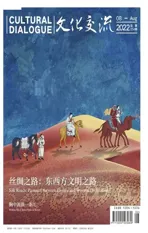从杭州到撒马尔罕,焕发全新活力
2022-08-26文/赵丰
文 / 赵 丰

乌兹别克斯坦希瓦古城墙。Filippo Gordini/ 摄©联合国教科文组织丝绸之路项目The city walls of Khiva, Uzbekistan. Photo by Filippo Gordini. Photo credit: UNESCO Silk Roads Program.
大约在公元658年前后,大唐皇帝唐高宗李治(628—683)册封拂呼缦(Varkhuman)为康居都督府都督,其实也就是康国的国王。高宗派出了一个使团,千里迢迢送上了珍贵的蚕茧、丝线和丝绸。同样来自东方的使者还有吐谷浑人,他们献上了代表财富的牦牛尾,邻近的石国(Chaganian)也派使者穿着鲜艳服装前来祝贺。拂呼缦的身边,依然有着众多的突厥武士佩刀守卫,当时突厥对粟特地区的影响非常大。不过,他特别把唐朝的使者放到了最中间。
这一盛会被康国的画家高手绘在了位于阿弗拉西亚卜(Afrasiab)的一处四方形建筑内的西墙上。20世纪,中亚考古学家在乌兹别克斯坦发现了这一遗址,并把这组壁画的所在地称为大使厅。
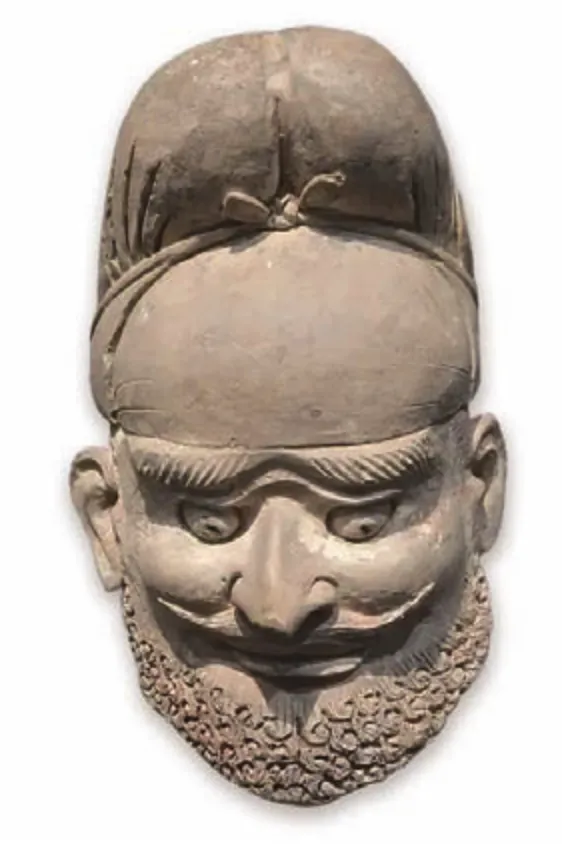
粟特人。Head of a statue of a Sogdian.
让历史渊源照亮丝路文化
作为著名的“丝绸之路”古国,乌兹别克斯坦共和国地处中亚腹地、东西方往来必经之地。因丝绸之路的开辟,让众多贸易重镇迅速崛起,成为中亚历史的核心和精华。其中的费尔干纳盆地是中亚地区历史文化遗迹中最为庞大和重要的地区。壁画中的康国正是今天乌兹别克斯坦第二大城市撒马尔罕,阿弗拉西亚卜曾是粟特人的都城。在唐朝年间,以撒马尔罕和布哈拉为中心区的乌兹别克斯坦西南部就已经是粟特人的主要居住区了。
世界各地的粟特学者对撒马尔罕大使厅的壁画进行了研究,其中被普遍接受的说法是,大使厅入口处的正对面是位于西墙的各国使者庆贺图。大使厅的南墙,则被推测有可能是表示石国(突厥语,位于乌兹别克斯坦首都塔什干市)国王的新年出行祭祀图,东墙画有唐高宗狩猎和武则天泛舟的场面,有人推测这是中国的端午节。而进门的北墙壁画保存最差,推测是与印度相关的图像。粟特人是丝绸之路上的贸易担当者,他们从小就跟着父母到处做生意,足迹遍布亚洲大地:比如,中亚的阿姆河和锡尔河,正是丝绸之路上东西南北的通道,是文明和商业的十字路口;向南是印度,向北是游牧的突厥、柔然、匈奴这些王国,往东到中国,向西就是波斯、罗马。另一方面,粟特人也善于织锦,加上他们陆续迁徙移居至中国西北和内陆地区,使他们的织锦与中国的织锦相互产生影响,提升了双方的丝绸生产技术。
这个大使厅目前已是撒马尔罕国立博物馆的壁画馆,它不仅成为古代中国以及古代亚洲各国与古代乌兹别克斯坦交往、交流、融合的有力见证,更在今天受到了来自世界各地尤其是丝绸之路沿线国家人民的广泛喜爱,成为他们来到乌兹别克斯坦撒马尔罕必打卡的旅游点。
以互展互动深化文化合作
2022年7月第三届丝绸之路周期间,中国丝绸博物馆与撒马尔罕国立博物馆在大使厅上层的展厅里共同举办名为“丝绸与丝路:从杭州到撒马尔罕”的特别展览。乌兹别克斯坦共和国旅游与文化遗产部文化遗产局第一副局长Tursunali Kuziev,撒马尔罕文化遗产局博物馆发展处处长Ziyodullo Nasimov,撒马尔罕国立博物馆馆长Samariddin Mustafokulov,撒马尔罕考古研究所所长Saidkhan Mominov,撒马尔罕国立外国语学院孔子学院乌方院长Shakhriyor Safarov,中方院长李晨旭等出席了这一展览开幕式。同名云上展览也同时上线。
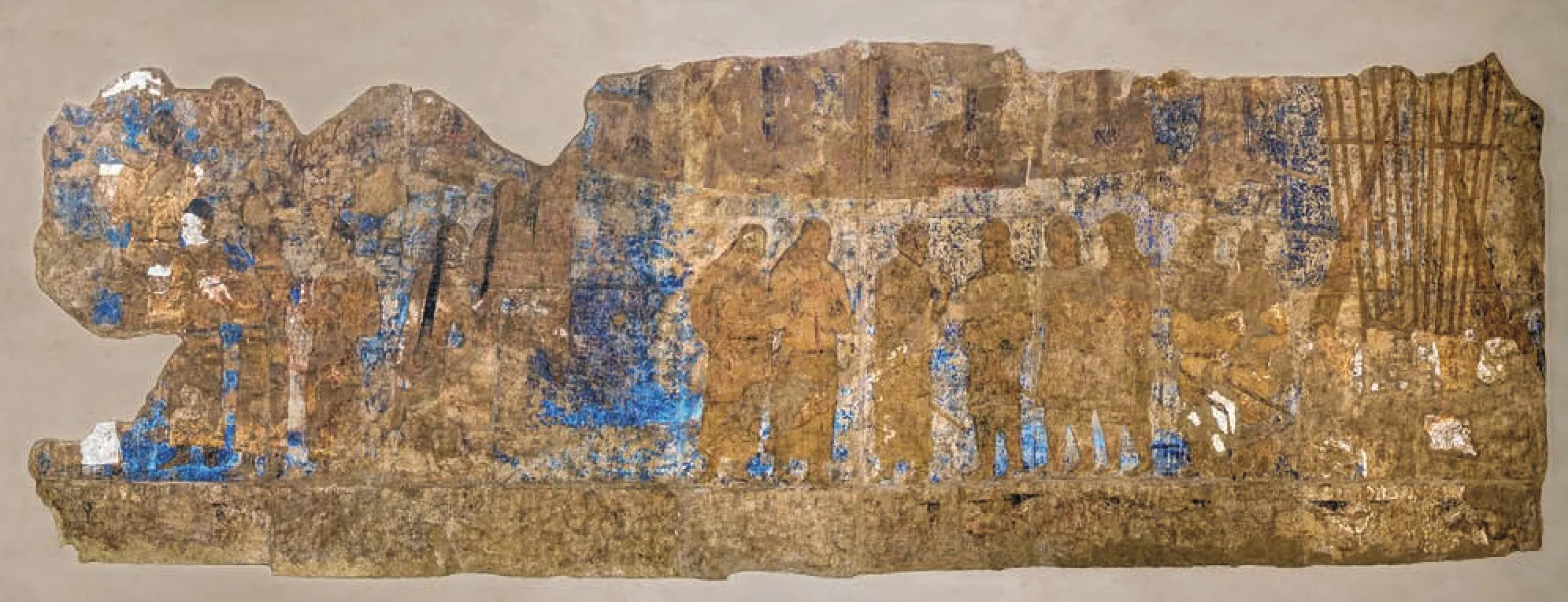
撒马尔罕古城大使厅西墙壁画。(图片来源:乌兹别克斯坦撒马尔罕国立博物馆)The mural on the west wall of the Hall of Ambassadors in Afrasiab, Samarkand. Photo credit: Samarkand State Museum-Reserve of Uzbekistan.
展览共分为三个单元。第一单元是从杭州到撒马尔罕丝绸之路沿途的重要考古遗址和出土的丝绸实物,其中包括郑州、西安、敦煌、吐鲁番、费尔干纳等重要节点。第二单元是整个展览的亮点,中国丝绸博物馆的策展团队用今天的电子提花织机,复制还原了大使厅壁画上的九种图案的中亚织锦,并用这些织锦再制作了石国使者的锦袍、大唐使者的绫袍,通过3D和2D图像的组合,生动地还原了壁画中6世纪中叶丝绸之路上一次多元文化相汇的“峰会”盛况。第三部分介绍了以中国丝绸博物馆牵头申报的联合国教科文组织(UNESCO)人类非遗项目“中国蚕桑丝织技艺”,从蚕桑到丝绸的传统生产技艺。
同时,展览还对这九件粟特织锦的图案和来历分别进行了详细的解释,使人们对6世纪前后中亚粟特地区的织锦有了更为深入的了解。
中国丝绸博物馆曾于2010年与乌兹别克斯坦共和国科学院考古研究所和东华大学服装艺术学院共同合作,首次针对费尔干纳盆地早期中古时代纺织服饰品进行了全面的综合性研究,并完成了《大宛遗锦:乌兹别克斯坦费尔干纳蒙恰特佩出土的纺织品研究》中英俄三语种同时出版的著作,成为中国和乌兹别克斯坦考古学和纺织历史研究领域专家的首次合作成果。中国丝绸博物馆目前正在跟乌兹别克斯坦考古研究所探讨蒙恰特佩出土的纺织品的修复项目。
而此次展览也是中国丝绸博物馆第一个赴乌展览,两馆在2022年5月签署了为期五年的合作谅解备忘录。双方合作的第一条款包括交换展览:中方将在撒马尔罕国立博物馆推出以丝绸、纺织品、服饰或与丝绸之路相关的主题。中方也将引入来自乌方的民族服饰等相关展览。
使合作交流焕发全新活力
“丝绸之路周”已连续成功举办三年,即使是在新冠疫情的影响下,仍然吸引了全球百余家文化机构的积极参与,并逐步成为一个全球性的交流、分享平台,其中的关键在于积极倡导合作,“合作”是“丝绸之路周”的生命力所在。
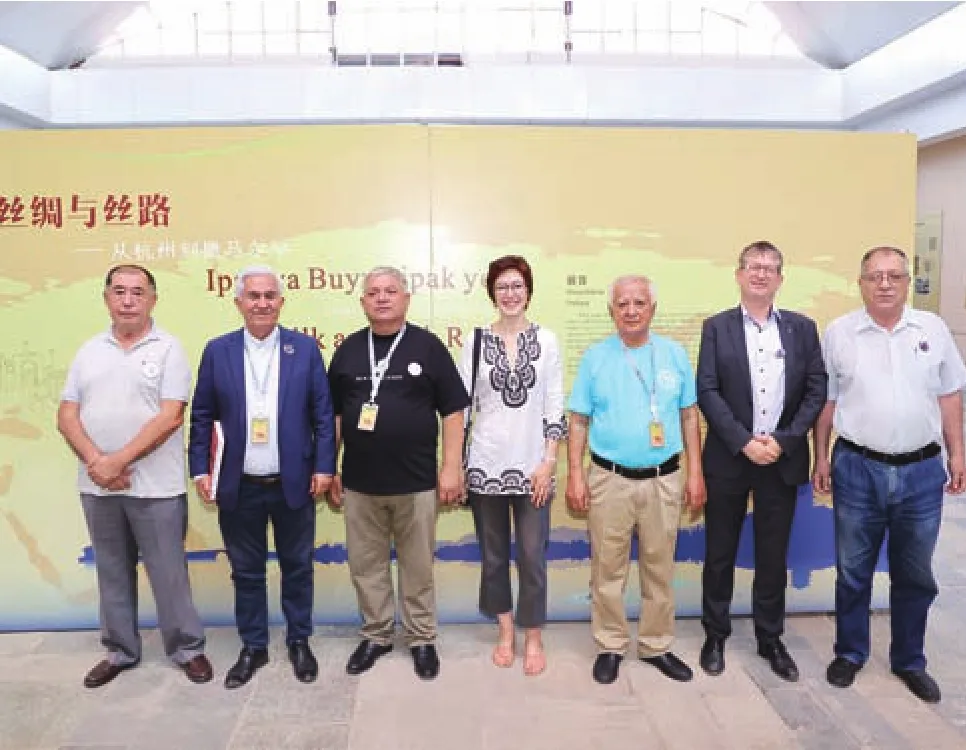
“丝绸与丝路:从杭州到撒马尔罕”展览开幕式。Guests of honor pose for a group photo at the opening ceremony of the exhibition Silk and the Silk Roads: from Hangzhou to Samarkand.
从“2020丝绸之路周”主题为“互学互鉴促进未来合作”,到2021年的“多元共存和包容发展”,再到今年定为“民族融合,共同繁荣”,可以看到许多“丝绸之路周”全球化进程中各国合作共享的案例。中国丝绸博物馆拥有丝绸、纺织品等方面的领先技术,撒马尔罕有诸多与丝绸之路相关的珍贵文物,通过“2022丝绸之路周”邀请乌兹别克斯坦共和国作为主宾国共同举办系列活动这一深入合作,彼此间形成互补,能携起手来更好地传播丝绸文化。
在此初衷的基础上,“丝绸之路周”在今年又有了新的尝试。主宾省、主宾国将会在此后的活动中一直承袭下去。接下来的每年,都会有主宾省与主宾国,若干年后,我们相信,世界上会有更多的人了解丝绸之路和丝绸文化。历史上的丝绸之路就是通过一代又一代人的交流、交往才延续至今,我们期待“丝绸之路周”也能架起东西方合作的纽带和桥梁。
正如主宾国代表、乌兹别克斯坦驻上海总领事马苏托夫·阿吉兹在今年“丝绸之路周”开幕式上所说的:“丝绸之路表明,文化交流是加强不同国家、不同民族之间相互信任的有效途径。”

“丝绸与丝路:从杭州到撒马尔罕”展览现场。Visitors take a photo at the exhibition Silk and the Silk Roads:from Hangzhou to Samarkand.
From Hangzhou to Samarkand: New Vitality
By Zhao Feng
In about the year 658, Li Zhi (628-683), Emperor Gaozong of the Tang dynasty (618-907) made Varkhuman (ca. 640-670),King of Samarkand, the Governor of Kangju (generally regarded as the Chinese variant of Sogdiana). For this, Emperor Gaozong sent an embassy with valuable silk cocoons, silk threads and silks. At the same time, the Tuyuhun people and the neighboring Chaganian sent their ambassadors as well, with the former presenting yak tails which signified wealth and the latter dressed in colorful clothes for celebration. Standing alongside Varkhuman were the many Turkic guards with swords, which shows the deep Turkic influence on Sogdiana. However, the emissaries from Tang had been specially placed at the very center by Varkhuman.
The details of the above spectacle were painted in a series of murals on the west wall of a rectangular building in Afrasiab, an ancient site of Northern Samarkand, present-day Uzbekistan. In the 20th century, archeologists from Central Asia discovered the site and named the place of the murals “Hall of Ambassadors”.
As an ancient country along the Silk Roads, the Republic of Uzbekistan is located in the hinterland of Central Asia, where the East and the West must pass through. Thanks to the opening of the Silk Roads, many important trade towns rose rapidly and became the core and essence of Central Asian history, of which the Fergana Valley boasts the largest number of and some of the most important historical and cultural sites in Central Asia. The Kingdom of Samarkand painted on the murals is the city of Samarkand, the second largest city in Uzbekistan today, and Afrasiab used to be the capital of Sogdians. During the Tang dynasty, southwestern Uzbekistan, centered around Samarkand and Bukhara, had already become the main area for Sogdian settlement.
Scholars on Sogdian history and culture from all over the world have studied the murals in the Hall of Ambassadors in Samarkand, and the most widely accepted theory is that main wall of the hall is the west wall on which is a painting of the envoys from various countries paying homage to King Varkhuman. The mural on the south wall of the hall is believed to show the New Year’s Day ritual of the King of Chaganian (located in Tashkent,the capital of Uzbekistan), while the east wall painting shows the hunting scene of Emperor Gaozong and Empress Wu Zetian (624-705) on a boat, which some argued represents China’s Dragon Boat Festival.
The north wall painting in the entrance is the worst preserved and is thought to be related to India. The Sogdians were among the best traders on the Silk Roads. They followed their parents to do business everywhere even when they were young and traveled all over Asia. For example, the Amu Darya and Syr Darya rivers in Central Asia were the north-south and east-west passages of the Silk Roads and at the crossroads of civilization and commerce. To the south was India, to the north were the nomadic Turkic and Rouran khaganates as well as the Xiongnu tribes, to the east lied China, and to the west were Persia and Rome. On the other hand,Sogdians were also good at weaving brocade, and their migration to the northwest and inland areas of China made their brocade interact with that of China and improved the silk production technology on both sides.
The Hall of Ambassadors has now become a mural hall of the Samarkand State Museum-Reserve of Uzbekistan. It has not only witnessed the interactions, exchanges and integration between ancient China, ancient Asian countries and ancient Uzbekistan,but also been widely loved by people from across the globe,especially countries along the Silk Roads. It is now a must-visit spot for tourists when they travel to Samarkand.
In July 2022, during the third Silk Road Week, the China National Silk Museum and the Samarkand State Museum-Reserve of Uzbekistan jointly held a special exhibition entitledon the upper level at the Hall of Ambassadors. Tursunali Kuziev, first deputy director of Uzbekistan’s Cultural Heritage Agency, Ziyodullo Nasimov, director of Museum Development at the Samarkand Cultural Heritage Bureau, Samariddin Mustafokulov, director of the Samarkand State Museum-Reserve of Uzbekistan, Saidkhan Mominov, director of the Samarkand Institute of Archaeology,Shakhriyor Safarov, head of the Confucius Institute at the Samarkand State Institute of Foreign Languages and Li Chen,the Chinese head of the Confucius Institute, among other guests,attended the opening ceremony of the exhibition. An online exhibition of the same title was also launched simultaneously.
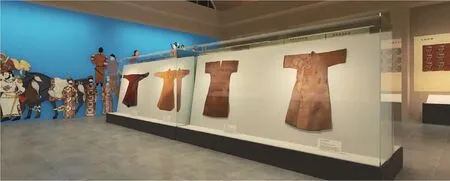
“丝绸与丝路:从杭州到撒马尔罕”线上展览。The online section of the exhibition Silk and Silk Roads: From Hangzhou to Samarkand.
The exhibition is divided into three parts. The first part focuses on important archaeological sites and silk items unearthed along the Silk Roads from Hangzhou to Samarkand, including major places such as Zhengzhou, Xi’an, Dunhuang, Turpan,and Fergana. The second part is the highlight of the whole exhibition. The curatorial team of the China National Silk Museum reproduced the nine pieces of the Central Asian brocades on the mural of the Hall of Ambassadors through the electronic jacquard loom, which were then used to make the brocade robe of Chaganian envoys and the satin robe of Tang envoys. Combining 3D and 2D imaging, it vividly reproduced the spectacular“summit” of the many cultures converging on the Silk Roads in the middle of the 6th century. The third part introduced the traditional production techniques from sericulture to silk, which,led by the China National Silk Museum, has been applied for the UNESCO Intangible Cultural Heritage of Humanity.
The Silk Road Week has been successfully held for three consecutive years. Despite the impact of the COVID-19 pandemic, it has attracted the participation of more than 100 cultural institutions around the world, and has gradually become a global platform for communication and sharing. The key is cooperation, which is at the heart of the Silk Road Week.
From the 2020 Silk Road themed “The Silk Roads: Mutual Learning for Future Collaboration” to the 2021 Silk Road Week themed “Cultural Diversity and Sustainable Development” and now to the 2022 Silk Road Week themed “National Integration and Common Prosperity”, we can see many a case of cooperation and sharing among countries in the process of the Silk Road Week going global. In 2020, focusing on world silk heritage, we launched the Silk Road Interactive Map, a 13-country cooperation project.In 2021, the Silk Road Online Museum was jointly established with nearly 40 museums from 16 countries, including the UK,the US and Russia. As the China National Silk Museum possesses state-of-the-art technologies silk and textile, and Samarkand is where many rare and precious cultural relics related to the Silk Roads lie, the initiative to invite the Republic of Uzbekistan through the 2022 Silk Road Week as the Guest Country of Honor and jointly hold a series of in-depth cooperation events has further promoted the silk culture.
The initiative of inviting a Guest Province of Honor and a Guest Country of Honor will continue in the future. After a few years, we believe that more people around the world will know more about the Silk Roads and silk culture. It is through generations of exchanges and interactions that the historical Silk Roads have survived until now. We hope that the Silk Road Week will also build a bond and bridge of cooperation between the East and the West.
Just as Aziz Masutov, the Uzbek Consul General in Shanghai,said at the opening ceremony of the 2022 Silk Road Week,“The Silk Roads show that cultural exchanges are an effective way to strengthen mutual trust between different countries and peoples.”
